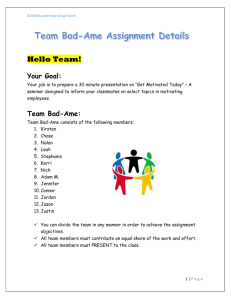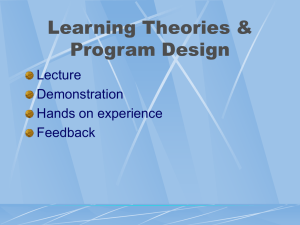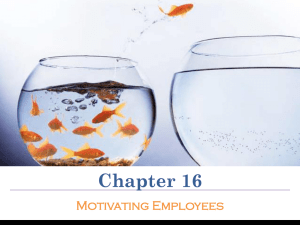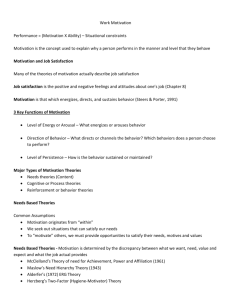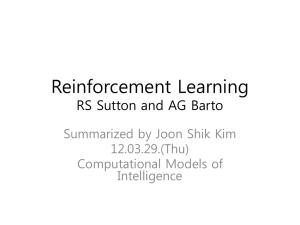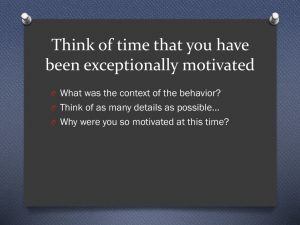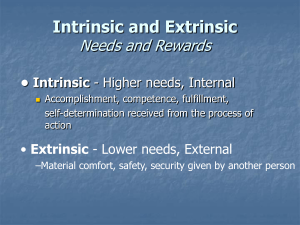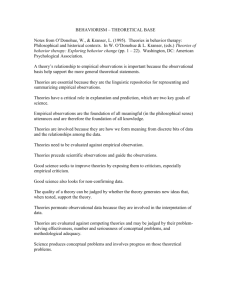Motivation
advertisement
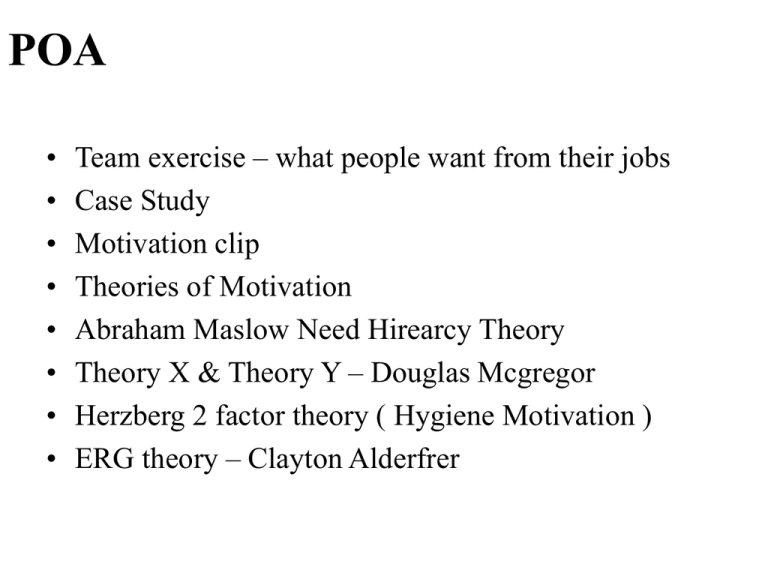
POA • • • • • • • • Team exercise – what people want from their jobs Case Study Motivation clip Theories of Motivation Abraham Maslow Need Hirearcy Theory Theory X & Theory Y – Douglas Mcgregor Herzberg 2 factor theory ( Hygiene Motivation ) ERG theory – Clayton Alderfrer MOTIVATION • Motivation is not permanent.. Neither is bathing – Over The Top – Zig Ziglar • Motivation is the fuel necessary to keep the human engine running Motivation Key Elements 1. Intensity: how hard a person tries 2. Direction: toward beneficial goal 3. Persistence: how long a person tries Inspiration Vs Motivation • Inspiration – a process which helps to change our thinking process • Motivation – a process which helps to change our actions. • Eg – the story of 2 brothers from same family Features of Motivation Continuous process Goal oriented Complex in nature Is an art Fold your goal in your pocket Motivation • Internal – within such as pride a sense of achievement, responsibility and belief, it is inner gratification that is fulfillment that comes from having done it. It is lasting and translates into self motivation. Eg – auto suggestions , +ve self talk in present tense regularly • Eg – the story of young boy and his father. • External – from outside. Money, societal approval, fame or fear, incentives, bonuses commission, etc Eg – fear of getting fired from the job, fear of getting spanked from parents. Eg – Pension plan story Myths Of Motivation I can motivate people simply on my own. Money is the best motivator I know what motivates me, so I know what motivates my employees. Eg The carrot and the donkey story 4 stages- from motivation to Demotivation 1. Motivated Ineffective- eg – a new employee in a new organization. Professional organizations take care while inducting people and explain them – hierarchy, expectations from each other ,do’s and don’ts, parameters and guidelines, what is acceptable and what is not, what are the resources. 2.Motivated Effective - the learned employee does the work with drive and energy 3. Demotivated Effective here the motivation level goes done and employee only does the work which is needed by the employer. This is detrimental to growth. Most of the employees fall into this category a motivated one learns the trade and leaves the tricks to cheats and crooks but a demotivated one starts sabotaging the company. 4. Demotivated Ineffective – An employer does not have much choice but to fire the employee 4 stages from Motivation to Demotivation in Employees Effective Ineffective Demotivated Motivated Ineffective Employee Effective Maslow’s Need Hierarchy Theory Higher-order needs Selfactualization Needs Personal growth Esteem needs Title, status, Social needs Formal & Informal group Safety needs Seniority plan, union, pension Physiological needs Lower-order needs Early theories of Motivation Theory X and Theory Y (Douglas McGregor) Early theories of Motivation Two-Factor Theory (Frederick Herzberg) Motivation and Hygiene Theory Early theories of Motivation Contd.. • Intrinsic factors related to job satisfaction and motivation – Achievement – Recognition – responsibility • Extrinsic factors related to job dissatisfaction – – – – Company policy Administration Supervision Interpersonal relationship Comparison of Satisfiers and Dissatisfiers Factors characterizing events on the job that led to extreme job dissatisfaction Factors characterizing events on the job that led to extreme job satisfaction Motivators and hygiene factors • • • • • • • Motivators achievement recognition work itself responsibility advancement growth • Hygiene factors – Supervision - company policy - Relationships with supervisor - Working conditions - Salary - Relationship with peers - Personal life - Status - Security ERG Theory (Clayton Alderfer) Concepts: Core Needs Existence: provision of basic material requirements. More than one need can be operative at the same time. If a higher-level need cannot be fulfilled, the desire to satisfy a lowerlevel need increases. Relatedness: desire for relationships. Growth: desire for personal development. Contemporary theories of Motivation POA • Motivation theories – – – – Goal setting theory Expectancy theory David McClelland’s theory Reinforcement theory • Motivation case study • Motivation clip Goal-Setting Theory (Edwin Locke) Goal Commitment Self Efficacy - refers to an individuals belief that he or she is capable of performing a task. To motivate goals must take into consideration Clarity- SMART eg – respond to employee suggestions in 48 hours, reduce job attrition by 15 % etc Challenge – more difficult goal, higher efforts and higher rewards Commitment – understood and agreed upon ( participative management) Feedback – any discrepancies could be found and worked Task complexity -give time to person to achieve and practice Contemporary theory Tips for building employee self efficacy • • • • • Don’t imply that employees are incompetent Don’t talk down to them about their jobs Don’t’ find petty faults with their results Don’t criticize their work in front of their peers Don’t belittle the importance of their jobs or tasks. Do praise them for their appropriate efforts Do ask for their input Do listen carefully to their ideas for improvements Do share positive feedback from their peers with them Do provide formal recognition for their achievement Expectancy Theory- Victor Vroom Expectancy Theory- Victor Vroom If I give maximum efforts will it be recognized • Design of Performance Appraisal System Performance Reward Relationship If rewarded are the reward ones that I find personally attractive Contemporary theories of Motivation David McClelland’s Theory of Needs Higher level mgmt nPow Personal Social nAch More observed in junior level and middle level mgmt nAff Middle level & Junior level Mgmt Matching Achievers and Jobs Contemporary theories of Motivation Reinforcement Theory Concepts: Behavior is environmentally caused. Behavior can be modified (reinforced) by providing (controlling) consequences. Reinforced behavior tends to be repeated. Contemporary theories of motivation Types of Reinforcement • Positive Reinforcement A reward or other desirable consequence that follows behavior Negative Reinforcement • Also known as negative reinforcement; rather than receiving a reward following a desirable behavior, the person is given the opportunity to avoid an unpleasant consequence • • Punishment An unpleasant, or aversive, consequence that results from behavior. Extinction Decreases the frequency of behavior by eliminating a reward or desirable consequence that follows that behavior. Kinds of Reinforcement Positive reinforcement and avoidance can be used to motivate desired behaviors by employees. figure 6.5 Kinds of Reinforcement Extinction and punishment can be used to change undesired employee figure 6.5 “Let me win. But if I cannot win, let me be brave in the attempt.” ------ World Summer Games shanghai 07
